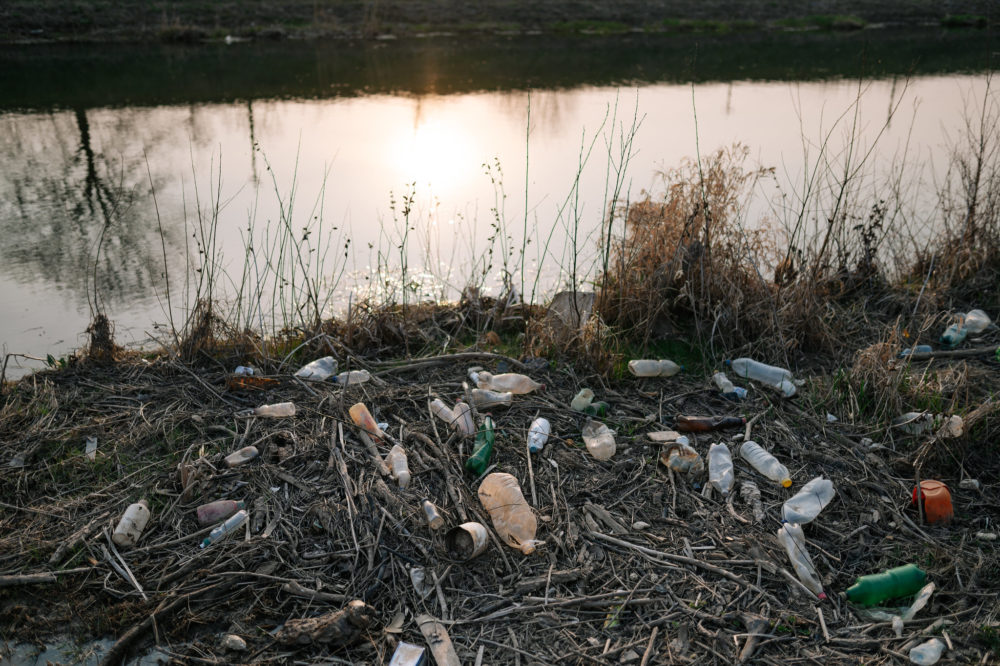We dropped over 8,000 pieces of litter into a fake river to fight plastic pollution

James Lofty, PhD Candidate in Hydrodynamics, Cardiff University, Catherine Wilson
Professor in Environmental Hydraulics, Cardiff University, Daniel Valero, Senior Lecturer in Fluid Mechanics, Imperial College London
Nobody really knows how much plastic is in the world’s rivers or where it accumulates.
Estimates of the amount of plastic entering the oceans from rivers range from 0.057 million to 2.75 million tonnes a year, or 10 to 250 bin lorry loads per day.
Plastic pollution can cause devastating effects to river ecosystems and the invertebrates, fish and mammals that live there. So improving these plastic estimates is vital.
This is why we’ve conducted research analysing how different pieces of litter behave in our waterways. We and our colleagues tracked the movement of more than 8,000 plastic items in large laboratory rivers, which can recreate the behaviour of real rivers under perfectly controlled conditions.
Plastic coffee cup
Consider the journey of a plastic coffee cup that has been carried by the wind or rain into a nearby river. Does the cup settle on the riverbed?
Does it break up and fragment into tiny microplastic particles? Or does the cup bounce along the riverbed transported by the flow?
Maybe the cup is suspended in the water column or floats on the surface where it can be transported large distances – even all the way to the ocean.
The number of different pathways a piece of plastic can take in waterways is diverse and complicated. Understanding the behaviour of plastic pollution in rivers may help to overcome this complexity. It could provide more accurate estimations of plastic pollution in our streams, rivers and freshwater systems.
If we know where the majority of river plastic pollution exists, we can design targeted methods to accurately count them and clean them up.
Bouncing and hopping
Our laboratory river is a long indoor glass tank with a controlled flow of water, which mirrors real river conditions. A variety of objects, from plastics to sediments, can be dropped into these fake rivers to study and measure how they move in real rivers.
The first experiment we conducted involved tracking the movement of tiny spherical microplastic particles bouncing and hopping along an artificial riverbed.
We recorded more than 11,000 different microplastic bounces, down to millimetre accuracy. Tracking these movements allowed us to characterise the behaviour of the microplastics under various conditions. We found that spherical microplastic particles behave in similar ways to natural sediment like sand and gravels.
This is good news because a large body of research has already been developed over the last century for describing how small sediment particles travel in rivers. This knowledge can be transferred to better predict the movement of microplastics in rivers.
Our second and third experiments focused on tracking the movement of common sinking and floating litter items, such as cups, films and face masks. We found that plastic items move in diverse ways in rivers, depending on their shape, size and density.
We discovered that both sinking and floating litter can be caught at the water surface like flies in a spider’s web. Once plastics are caught by this surface tension, they cannot easily escape. This causes a build-up of plastic travelling on the river’s surface.
Those plastics which travel on the surface are easy to observe and count in rivers. But when the river flow increases, plastics may dive beneath the water’s surface, which makes them more difficult to count and monitor.
The data we collected was used to adapt the equations which were previously developed for sediments, to predict the total amount of plastic that travels in rivers. The equations could improve the monitoring of plastic pollution. The data also provides us with a better description of how plastic is transported in rivers.
Solving the plastic crisis is just beginning. But our experiments take us one step closer to having a more realistic picture of plastic pollution in rivers, as well as where to focus any cleanup efforts.
This article was first published on The Conversation
![]()
Support our Nation today
For the price of a cup of coffee a month you can help us create an independent, not-for-profit, national news service for the people of Wales, by the people of Wales.







Good article, and an interesting find that microplastics behave in a similar fashion to transported sediments.
Are Dwr Cymru carrying out similar experiments on examples of organic matter and how they are carried through our waterways?